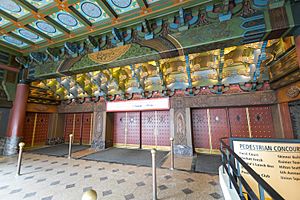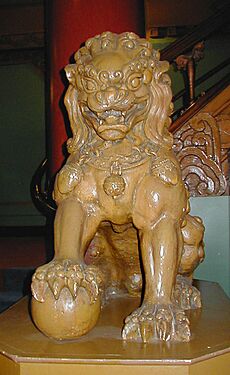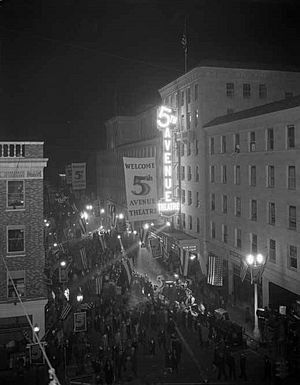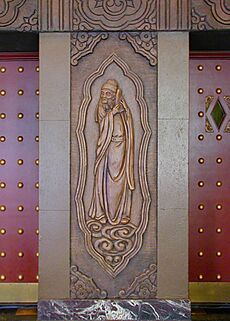5th Avenue Theatre facts for kids

5th Avenue Theatre marquee, Holiday 2016
|
|
| Address | 1308 5th Avenue Seattle, Washington 98101 |
|---|---|
| Coordinates | 47°36′33″N 122°20′02″W / 47.6092°N 122.3340°W |
| Owner | University of Washington |
| Operator | 5th Avenue Theatre Association |
| Capacity | 2,130 |
| Construction | |
| Built | 1925 |
| Opened | September 24, 1926 |
| Architect | R.C. Reamer |
|
Skinner Building / Fifth Avenue Theater
|
|
| Lua error in Module:Location_map at line 420: attempt to index field 'wikibase' (a nil value). | |
| Area | 1 acre (0.40 ha) |
| Architectural style | Late 19th and 20th century revivals, Italian Renaissance |
| NRHP reference No. | 78002756 |
| Added to NRHP | November 28, 1978 |
The 5th Avenue Theatre is a famous theatre in Seattle, Washington, United States. It is located in the Skinner Building in downtown Seattle. Since it opened in 1926, it has shown many different plays and movies.
The University of Washington owns the theatre building and the land. The 5th Avenue Theatre Association, a non-profit group, runs the theatre. They bring in popular Broadway shows and create new ones.
This theatre has 2,130 seats. It is home to the 5th Avenue Musical Theatre Company. Over 600 people work there, including actors, musicians, and staff. This makes it the biggest theatre employer in the Puget Sound area. The theatre company is a non-profit. It gets support from donations, government funds, and ticket sales.
Each year, the 5th Avenue Theatre presents six to seven shows. These include classic musicals, new shows trying out for Broadway, and national touring musicals. The theatre is known as a "testing ground" for new musicals. Many shows like Jekyll & Hyde, Hairspray, and The Wedding Singer started here before going to Broadway. The theatre also hosts special events and offers programs for students and adults. These programs reach over 61,000 people each year.
Contents
Theatre Design and Style
The 5th Avenue Theatre is inside the Skinner Building. This building is a historic office block with shops on the ground floor. The theatre's entrance faces 5th Avenue. Inside, there is a large entry hall and a mezzanine level. The theatre originally had 3,000 seats.
The architect, Robert C. Reamer, designed the theatre to look like famous buildings in Beijing, China. A Norwegian artist named Gustav Liljestrom helped create the design. He used ideas from his trip to China and a book about Chinese architecture.
The theatre's inside style is very different from the outside of the Skinner Building. The outside looks like old European buildings. But when you step inside, you see beautiful Chinese designs. The ceiling at the entrance has plaster decorations that look like wooden brackets and beams. These are painted with bright colors and have dragons and flower patterns. Lights are hidden behind carved cloud shapes. This creates a soft, glowing effect.
The main lobby is two stories tall. It has red columns that look like wood. They support a roof with painted beams and a bamboo-like canopy. Two guardian lions, often called "foo dogs," stand at the stairway. They guard the way to the balcony. Many original decorations and light fixtures are still there.
The main attraction in the 2,130-seat auditorium is the large octagonal ceiling design. From this design, a sculpted five-toed Imperial Chinese dragon appears to spring out. A large glass chandelier hangs from the dragon's mouth. This represents a Chinese symbol of a dragon releasing flaming pearls. Some say this ceiling design is twice as big as the one it's based on in the Forbidden City in China.
The dragon design is repeated throughout the theatre. You can also see the Chinese phoenix, which is a symbol of the Empress. This bird appears in relief above false balconies. Other decorations include orange blossoms, chrysanthemums, and lotus flowers. Even the stage arch and safety curtain have Chinese designs.
When it was first built, the theatre had cool technical features. The orchestra pit could move up and down. The ventilation system had controls to keep the air fresh. Air was even "washed" before it entered the theatre.
Why the Theatre is Special
The 5th Avenue Theatre is very important. It opened before Grauman's Chinese Theater in Hollywood. It has been called the largest and most real example of traditional Chinese wooden architecture outside of Asia. Its architect, Robert Reamer, also designed the famous Old Faithful Inn in Yellowstone National Park. The Skinner Building, which houses the theatre, was added to the National Register of Historic Places in 1978.
Theatre History
Building the Theatre
In the 1920s, Harry C. Arthur, a theatre company president, thought Seattle was a great place for movies. He wanted to expand his theatre business there. C. D. Stimson, who owned a lot of the theatre company's stock, also wanted a theatre district in Seattle. The planned Skinner Building, with Arthur's theatre, would complete Stimson's big development project.
Architect Robert Reamer designed the building and the theatre. Joseph Skoog and Gustav Liljestrom also helped with the theatre's design. Construction started in October 1925. It took 11 months to build and cost $1.5 million.
Grand Opening Day
The theatre officially opened on September 24, 1926. The opening night included a silent film called Young April and live vaudeville performances. Oliver Wallace, a popular local musician, played the organ.
The opening was a huge party outside the theatre too. Several blocks of downtown Seattle were closed to cars. Thousands of people came, drawn by free rides and the excitement. The Seattle Times newspaper said that it was one of the busiest nights in Seattle's history.
A street carnival took place outside. Bright spotlights lit up the sky, and flares were shot from nearby rooftops. Dance bands played music at intersections. People even sang along to songs projected on giant screens. An estimated 50,000 to 100,000 people joined the celebration.
Troubles and Reopening
After its grand opening, the theatre showed vaudeville acts and movies. But in the 1970s, fewer people came. This was because of money problems, the rise of television, and new movie theatres in the suburbs. The theatre had to close in 1978. People suggested turning it into a restaurant, a shopping center, or offices. The city couldn't easily protect it as a landmark because the land belonged to the state.
In 1979, 43 business leaders stepped in to save the theatre. They formed the non-profit 5th Avenue Theatre Association. They raised $2.6 million to restore it. Architect Richard McCann led the restoration work.
Some changes were made during the renovation. The old vertical sign was removed. The orchestra pit and seating were rebuilt. Dressing rooms were moved, and technical systems were updated. However, the original furniture, decorations, and paint were carefully restored. The renovation made the theatre ready for live shows again.
On June 16, 1980, the theatre reopened. Actress Helen Hayes kissed the stage and called the 5th "a national treasure." The first touring Broadway musical, Annie, opened on July 3. It was a huge success, selling out for 10 weeks. The 5th Avenue Theatre continues to do well today, thanks to many donors and volunteers.
Recent History
Since its reopening, the 5th Avenue Theatre has become one of Seattle's most important theatres. In 1989, The 5th Avenue Musical Theatre Company was created. This is the theatre's own non-profit company that produces musicals.
On February 28, 2001, the Nisqually earthquake shook the theatre. Actors were rehearsing a musical called 1776 at the time. The theatre had only minor damage. Workers had to fix cracks and damaged plaster in the ceiling. They even installed scaffolding to reach the highest parts of the ceiling, which hadn't been touched in 75 years.
In November 2009, a new vertical sign was put up. It looks like the old sign that was removed in 1980. This new sign uses LED lights to save energy. It also has a spinning "5th" sign at the top.
The 5th Avenue Musical Theatre Company
How it Started
From 1980 to 1985, the 5th Avenue Theatre mostly hosted touring Broadway shows. But during an economic slowdown from 1985 to 1989, there weren't as many touring shows. So, the theatre decided to start producing its own musicals.
In 1989, the 5th Avenue Theatre created its own resident theatre company. It was called The 5th Avenue Musical Theatre Company. Since then, the company has produced 6 to 7 shows each year. These include national touring musicals, classic musicals, and new shows trying out for Broadway. The 5th is one of the largest musical theatre companies in the country. It has about 150 performances each season and sells around 300,000 tickets annually.
The musical company employs over 600 people. This makes the 5th the biggest theatre employer in the Puget Sound region. As a non-profit, the company gets money from donations, government sources, and ticket sales.
Partnerships and New Leadership
Frank M. Young was the first leader of the 5th Avenue Musical Theatre Company. From 1989 to 1999, the 5th worked with Houston's Theatre Under the Stars (TUTS). They produced 10 seasons of musicals together. In 1995, Jekyll & Hyde premiered at the 5th. It was the first 5th Avenue Theatre production to open on Broadway in 1997.
In 2000, the partnership with TUTS ended. David Armstrong became the new Producing Artistic Director. This started a new time of working with other theatre companies across the country.
Broadway "Testing Ground"
Since 1989, the 5th Avenue Theatre has been a "testing ground" for new musicals. This means new shows are performed here before they go to Broadway. Since 2001, the 5th has premiered 17 new works. Nine of these shows later opened on Broadway.
David Armstrong, the Producing Artistic Director, said, "We've become a very sought-after partner for developing Broadway musicals."
Some famous musicals that started at the 5th Avenue Theatre before Broadway include:
- Jekyll & Hyde in 1995 (nominated for 4 Tony Awards).
- Hairspray in 2002 (won 8 Tony Awards).
- The Wedding Singer in 2006 (nominated for 4 Tony Awards).
The movie version of Hairspray even premiered at the 5th in 2007. This was to thank the theatre for its role in the musical's success. The "testing ground" tradition continued with Shrek the Musical and Memphis. Both won Tony Awards. Catch Me If You Can also premiered here before Broadway. More recently, A Christmas Story: The Musical and Disney's Aladdin started at the 5th. First Date also premiered here before heading to Broadway.
Not all shows that start at the 5th go to Broadway. Some, like Princesses and Lone Star Love, were planned for Broadway but didn't make it.
Community Programs
The theatre also offers many education programs for students and adults. These programs reach over 61,000 people each year. One example is the 5th Avenue High School Musical Theatre Awards. These awards celebrate the performances of student actors and stagehands in Washington state high school productions. A special awards ceremony is held each year, like the Tony Awards. Colleges often use this event to find talented students for their drama programs.
Past Shows
The 5th Avenue Theatre has hosted many amazing shows over the years. Here are some of the musicals they have presented:
2025-2026 Season
- Suffs (September 12 - September 27, 2025)
- Chicago (October 22 – November 2, 2025)
- Elf (November 28 – December 28, 2025)
- Monty Python's Spamalot (February 4 - February 15, 2026)
- Jesus Christ Superstar (May 2 – May 17, 2026)
2024-2025 Season
- Mary Poppins (November 22 – December 22, 2023)
- The Last Five Years (February 8 – March 16, 2025), with ACT Theatre
- Waitress (March 11 – March 30, 2025)
- Parade (April 16 – May 4, 2025)
- Bye Bye Birdie (June 10–29, 2025)
- After Midnight (August 5 – 24, 2025)
2023-2024 Season
- 1776 (August 2 – 6, 2023)
- The Little Mermaid (September 8 – October 8, 2023)
- Cambodian Rock Band (September 29 – November 5, 2023), with ACT Theatre
- White Christmas (November 25 – December 27, 2023)
- Something's Afoot (March 1-24, 2024)
- Spring Awakening (June 7-30, 2024)
- Clue (July 9-21, 2024)
2022–2023 Season
- The Griswolds' Broadway Vacation (September 10 – October 2, 2022)
- Choir Boy (September 11 – October 23, 2022), with ACT Theatre
- The Wiz (November 20 – December 23, 2022)
- Into the Woods (February 10 – March 5, 2023)
- Sweeney Todd (April 21 – May 14, 2023)
- Les Misérables (May 24 – June 17, 2023)
2021–2022 Season
- Beauty and the Beast (January 12 – February 6, 2022)
- Afterwords (April 29 – May 21, 2022)
- And So That Happened... (May 17 – June 26, 2022), at ACT Theatre
- The Prom (May 31 – June 19, 2022)
- Come from Away (July 20 – August 7, 2022)
2019–2020 Season
- Austen's Pride (October 4–27, 2019)
- Mrs. Doubtfire (November 26 – December 29, 2019)
- Bliss (January 31 – February 23, 2020)
Some shows planned for 2019-2020 and 2020-2021 were canceled due to the COVID-19 pandemic.
2018–2019 Season
- Come from Away (October 9 – November 4, 2018)
- Annie (November 23 – December 30, 2018)
- Rock of Ages (February 1–24, 2019)
- Marie, Dancing Still (March 22 – April 14, 2019)
- Urinetown (April 6 – May 26, 2018), with ACT Theatre
- The Lightning Thief (April 23–28, 2019)
- West Side Story (May 31 – June 23, 2019), with Spectrum Dance Theater
2017–2018 Season
- Something Rotten! (September 12 – October 1, 2017)
- Ragtime (October 13 – November 5, 2017)
- Irving Berlin's Holiday Inn (November 24 – December 31, 2017)
- Mamma Mia! (February 2–25, 2018)
- Ride the Cyclone (March 10 – May 20, 2018), with ACT Theatre
- Kiss Me, Kate (April 6–29, 2018)
- The Hunchback of Notre Dame (June 1–24, 2018)
See also
 In Spanish: 5th Avenue Theatre para niños
In Spanish: 5th Avenue Theatre para niños
- Paramount Theater, Seattle's other theater producing Broadway Musicals
- Fox Theater (Spokane, Washington)





